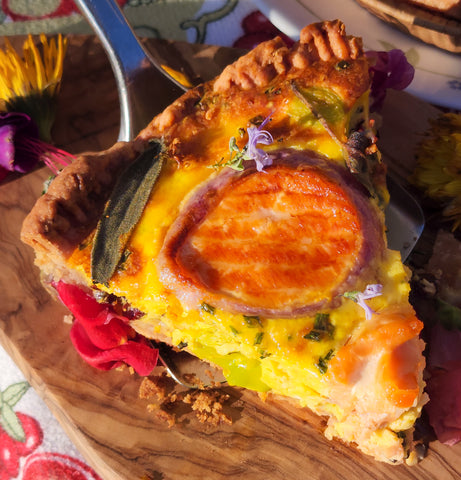Salmon Quiche
Share
From the Lorraine region of France, a quiche is a savory open faced tart filled with cheese, eggs, and a choice of protein. This salmon quiche can be served as a starter or brunch dish enjoyed at room temperature or a little warm, so the quiche crust is still crunchy!
Brought to you by @c.health.and.wellness

Ingredients:
- Two 6oz portions of Legal Sea Foods Online Shop's Salmon Filets
- 1 1/4 cups flour
- 7 tbsp butter
- 3 tbsp orange juice (more if needed - I used blood oranges for color)
- 2 tbsp orange zest
- 6 large eggs
- 3/4 cup heavy cream
- 1 1/2 cups cheddar cheese
- 1/3 cup chives
- a few sage leaves
- 1 bell pepper
- 1 tsp sea salt
Instructions:
- Place flour, sea salt, butter and orange zest in food processor or stand mixer. You can also mix by hand. Mix until crumbs form, and pour 3 tbsp of orange juice in. Add more orange juice accordingly if quiche dough is too dry.
- Refrigerate for 1-3 hours. Prepare your salmon by using a small cookie cutter or cut into cubes. Set aside, and prepare your quiche base by mixing eggs, cream, herbs, vegetables, and cheese.
- Preheat your oven to 375F. Roll out your quiche crust and prick your quiche crust with a fork before adding weight. Add weight (I used dried beans) to bake for 10-12 minutes.
- Remove your quiche weight and add in quiche egg mixture. Top with salmon.
- Bake for 35-40 minutes until center is completely set. Let rest at room temperature for 5-10 minutes before slicing and serving! Enjoy!
Helpful Tips:
- I bake the quiche crust beforehand so the bottom does not get soggy and holds up.
- I leave the salmon in larger chunks to prevent the salmon from drying out. I find if the salmon is shredded or cut in small cubes, it tends to be dry especially for reheating.
- If your salmon is starting to form a white layer, remove from heat or lower heat.
- If your quiche crust is getting too golden, add tin foil around your outer crust.
- Work fast with rolling out your quiche crust. The quiche crust is more difficult to handle when lukewarm at room temperature.
- Quiches can become watery from overcooking or undercooking your eggs. The heat will continue to cook your quiche even when your quiche is removed from the oven.
